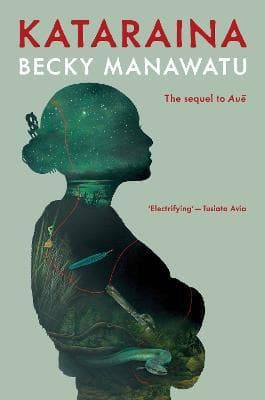Review: Kataraina, by Becky Manawatu
Reviewed by Kelly Ana Morey
Because I’m probably the only person in the country who hasn’t read Becky Manawatu’s beloved first novel Auē, her second novel Kataraina which is both a prequel and a sequel to Auē had to stand on its own merit. Fortunately it mostly does, such is the quality of the writing and the compelling nature of Manawatu's characters.
The novel, obviously, centres around its eponymous character Kataraina who features in Auē but as a supporting rather than main character. Little sister to twins Toko and Aroha and whāngai to Ārama in Auē, Kat’s story is one that breaks your heart just a little bit, page by page as her choices, many of which don’t serve her well but in many ways are wholly understandable, are slowly revealed to the reader. But stabbing you repeatedly in the heart is Manawatu’s forte and she’s very good at it. The central fulcrum of the novel is ‘the girl shot the man’, a variation, mostly ‘before’ and ‘after’, of which names most of the chapters and sets the time period of each. Within this are four different variations of Kat herself: Kat, Mess-Kat, Swamp-Kat which is while she’s in a coma, and City-Kat. Then there’s the research team in 2020 working on a swamp beside the house that Kat lived in with Stuart, and two other narrative threads that follow a female antecedent of Stuart’s and her sad fate and another from the Te Au family who killed a man with his ‘own industrial tool’.
Suffice to say there’s a lot going on and it isn’t always clear which isn’t always such a bad thing. It doesn’t have to be black and white, especially in a novel which has such a mythical, almost ancient and other worldly feel about it. This is supported by the swamp which/who is central to the novel, not just as a setting but as a lead character. Despite Stuart’s family's attempts over the years to drain it and turn it into arable farmland, the swamp has resisted and fought back. It’s still there, almost on life support, until ‘the girl shot the man,’ when it comes back with a vengeance. Almost as if a curse has been lifted.
There is a near constant shimmer of violence running through the novel; it’s about a series of murders and domestic violence after all. However, it’s never portrayed as a cultural failure or identification. It’s down to the failings of the individual and Manawatu handles this with great subtlety, showing the ways women and children creep around carefully, always trying to placate the men in their lives and their rage and disappointment. This isn’t a specifically Māori malaise, domestic violence doesn’t see colour, it just happens that Manawatu’s characters are Māori and the handling of domestic violence throughout the novel is indicative of Manawatu’s emotional intelligence.
For me the real triumph of Kataraina is Manawatu’s literariness and intensely lyrical writing. Her descriptions of the swamp and the whenua at large are where the poetry of her language really shines. You can tell she reads a lot and loves words. This is no small thing in a publishing climate that seems to be producing novel after novel that are narratively straight forward and tell a clear story in a linear fashion with lesser and greater degrees of success. But not Manawatu. She’s a far more ambitious writer than that, especially structurally, because time isn’t a linear concept so the novel moves backwards and forward across multiple narrative threads, and I love her for this. Because as a reader I want to be intrigued and challenged.
My only real difficulty with Kataraina was who was the girl who shot the man? Because she isn’t identified other than as ‘the girl’ and there’s no consequences like a police investigation or trial within the context of the novel I couldn’t quite pin it down. Figuring it wasn’t beyond reason that this plot point might have been revealed in Auē I read a couple of the early reviews for Kataraina and discovered that this is indeed the case. And to be honest, I was surprised, because Beth barely exists as a named character in Kataraina even though ironically she’s writ large across the entirety of the novel as ‘the girl’. For me this proved problematic and while I appreciate that this is part of the novel’s central conceit, it still needs to stand on its own merit without Auē having to provide plot or character support. It may be a small quibble but for a reader coming to the table for the first time with Kataraina it could prove to be too much of a stretch for the identification of ‘the girl’ to not be revealed especially given that the novel is entirely structured around her shooting Stuart who thankfully is named as ‘the man’ from the novel’s outset. Other than that it was a rare joy to read a novel that refuses to be in any way conventional or ordinary.
Reviewed by Kelly Ana Morey
